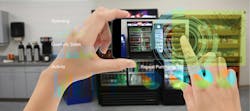As micro markets proliferate faster than Ferraris at the Indy 500, their success is often dependent on their widespread adoption by employees and other patrons. Equally challenging can be the use of micro market mobile apps. Done well, they can turn a micro market into a “macro market.”
Delight and reward
The trick, say many micro market suppliers, is to “delight,” reward and offer discounts and promotions to users. In a 2015 interview with VendingMarketWatch.com, Avanti Markets’ previous president, Lori Salow Marshall, said “Consumer engagement is key. Enabling support in the app with FAQs, feedback forms and support requests that are routed based on the type of request will give operators a new way to connect with and delight their consumers.”
And while the functional aspects of a micro market mobile app are critical — like making payments, checking account balances, loading funds, viewing transaction history and reading nutritional information — the promotional aspects can prove a bit more challenging.
Examples of successful micro market promotions include, but are not limited to:
- Creating unique deals (like those below) that are only available to users of the mobile app;
- Combining products for a discount;
- New product introductions/sampling;
- BOGO offers;
- Healthy items or rewarding employees for purchasing a certain quantity of healthier snacks and beverages;
- Special offers for limited time period (to motivate users to check their mobile apps throughout the day);
- Discounting fresh products (or others) before they expire; and
- Partner-driven promotions and offers with product suppliers
Go with current events
Promotions that follow a specific theme, like company anniversaries or employee recognition days, work especially well. In a December 2016 blog post, Renee King, marketing manager at Southern Refreshment, said, “When implementing a promotion, it always helps to follow current trends or events. Whether it’s a big game, holiday or the latest diet fad, a promotion that ties in with these is a great idea.
“With health on everyone’s mind, Southern is currently running a promotion for the New Year called ‘New Year New You’. We have highlighted better-for-you Choice Plus items to run for 25 percent off,” she said at the time.
A January 2017 article in VendingMarketWatch.com highlighted a holiday promotion conducted by the PayRange mobile app in 300 cities across the country: http://bit.ly/2xtKzFN
Notably, the benefits of the promotion, according to PayRange, were:
Activity: Participating operators avoided the expected seasonal drop.
Sales: The promotion provided a 13 percent lift in operators’ December sales.
Spend: New users, defined as those who had not purchased yet, spent eight percent more.
Repeat purchase: 40 percent of holiday program users made four purchases or more.
Deals and promotions should be run at the location level, as well as geographically and nationally, if possible. And mobile apps should always be free to download and made available in the App Store for iPhones and Google Play for Android devices.
Promote, promote, promote
Operators should use marketing materials to promote the adoption of mobile apps, including kiosk advertisements, flyers, brochures and communications for location managers and employees. Emails sent directly to employees can also work well — for both adoption and use of the mobile app — but a word of caution: sending too many emails can result in recipients opting out or unsubscribing from emails.
Mobile apps can also be used as a way for operators to build social media followers, then use such platforms as Facebook and Twitter to push messaging back to consumers. If Twitter is being used, be sure to use a Bitly link shortener (https://bitly.com/) to keep tweets to their 280-character limit.
Another way of promoting new products is utilizing digital advertising and displaying new items on monitors and kiosks. In fact, many of the ideas for mobile app promotions can be translated into comparable verbiage for digital signage. Some operators utilize digital signage to feature a variety of promotions geared toward particular products that are unique to certain locations, or are regional in nature.
Taken together, onsite signage and mobile app promotions can be very powerful marketing tools for operators. According to 365 Retail Markets CEO Joe Hessling, “Combining digital signage, kiosk backgrounds and messaging through [mobile apps] is the ultimate in omni-channel advertising within [micro markets].”
# # #
John Healy is Co-Founder of The Vending Marketer -- www.vendingmarketer.com -- a digital marketing agency that exclusively serves vending, OCS, micro market and other refreshment services businesses. He is also CEO of Healy Consulting & Communications Inc., a traditional, digital and social media marketing firm that strives to ensure its clients’ relevance while fueling their growth and success. His affiliation with the industry dates back to 2009, and he currently serves as a NAMA Knowledge Source Partner. Reach him at [email protected]
About the Author
John Healy
John Healy is Co-Founder of The Vending Marketer -- www.vendingmarketer.com -- a digital marketing agency that exclusively serves vending, OCS, micro market and other refreshment services businesses. He is also CEO of Healy Consulting & Communications Inc., a traditional, digital and social media marketing firm that strives to ensure its clients’ relevance while fueling their growth and success. His affiliation with the industry dates back to 2009 through his image campaign work for NAMA. Reach him at [email protected]

